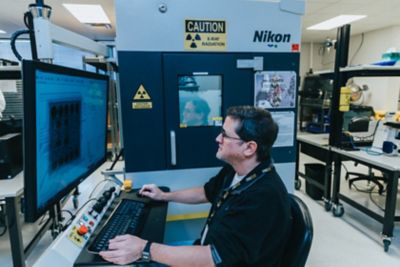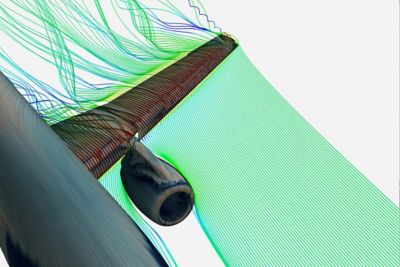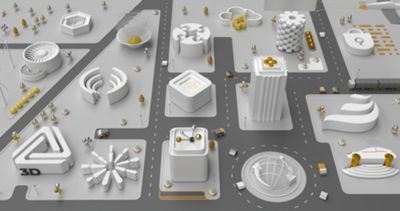Digital Engineering ist nicht mehr nur ein Schlagwort, sondern ein wichtiger Weg zur Innovation. Mit Ansys 2025 R1 wird die Zukunft der technischen Simulation noch schneller, intelligenter und effizienter. Diese neueste Version bringt bahnbrechende Fortschritte in den Bereichen KI-gestützte Simulation, GPU-Beschleunigung, Modellierung auf Systemebene und Cloud-Computing mit sich und ermöglicht es Techniker*innen, Grenzen wie nie zuvor zu erweitern.
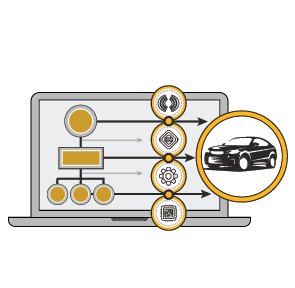
Ansys Digital Engineering: Schlüssel zur Entwicklung komplexer Systeme und Produkte der nächsten Generation
Ansys ist Technologiepartner für Digital Engineering. Unsere marktführenden Lösungen verbessern die technische Zusammenarbeit und bringen physikbasierte Simulationseinblicke früher in die Entwicklung ein, um die Umsetzung ganzer Systeme in führende Produkte zu beschleunigen. Wir unterstützen Sie bei Ihrer digitalen Transformation, um komplexe Systeme zum Leben zu erwecken.

Auflösen der Systemkomplexität mit marktführender Analyse
Ansys bietet ein modellbasiertes Systemtechnik-Framework, das Techniker*innen die Möglichkeit gibt, neue Komplexitätsstufen anzugehen. Die Integration leistungsstarker Physik-Solver in die digitalen Modelle, die diese Systeme darstellen, sorgt für beispiellose Genauigkeit. Modelle, denen die Teams vertrauen können, spiegeln die Realität wider und verringern die Abhängigkeit von physischen Prototypen.
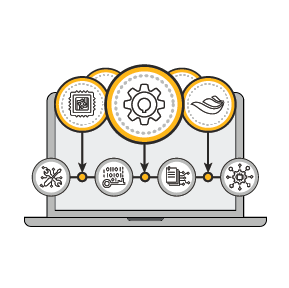
Die Flexibilität, sich im Tempo der Technologie weiterzuentwickeln
Unsere offenen Ökosystemlösungen ermöglichen es Unternehmen, die Technologie, die sie benötigen, in ihr Ökosystem für Digital Engineering aufzunehmen. Dies schafft neue Möglichkeiten für die Beschleunigung von Simulationen oder die Erforschung neuer Designumgebungen mit einer wachsenden Palette von KI-basierten Anwendungen. Skalieren Sie mit Cloud-basierter Simulation und HPC, damit Sie der Entwicklung Ihres Unternehmens folgen können.

Produkt-Highlights
Ansys 2025 R1 ist unsere neueste Version, die Technikunternehmen mit modernsten Tools für ein rigoroses Digital Design und die Produktbereitstellung in der Praxis ausstattet. Das Herzstück von R1 sind bahnbrechende Fortschritte bei grundlegenden physikbasierten Lösungen, die nahtlos in alle technischen Bereiche integriert sind. Unsere verbesserten Solver und Tools auf Plattformebene nutzen die Leistungsfähigkeit der künstlichen Intelligenz und ermöglichen eine effizientere Untersuchung von Konstruktionen sowie tiefere Einblicke. Dadurch wird die Art und Weise, wie Teams komplexe Herausforderungen meistern, grundlegend verändert.
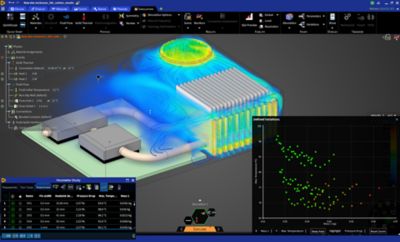
3D-Design
Ansys Discovery 2025 R1 bietet leistungsstarke neue Funktionen, die den gesamten Workflow für die Untersuchung und Simulation von Konstruktionen verbessern. Funktionen wie die Erkennung der Machbarkeit von Sweep-Vernetzung und die Erstellung benutzerdefinierter Balken machen die Modellvorbereitung effizienter. Beschleunigen Sie komplexe Simulationen der elektronischen Kühlung mit GPU-basierter automatisierter Vernetzung und erweiterten elektromagnetischen Funktionen. Schließlich können Sie die Untersuchung von Konstruktionen durch mehr Untersuchungsdurchgänge in kürzerer Zeit mit weniger Aufwand auf ein neues Niveau bringen, indem Sie in die Cloud starten und Tausende von Simulationen in Minuten lösen.
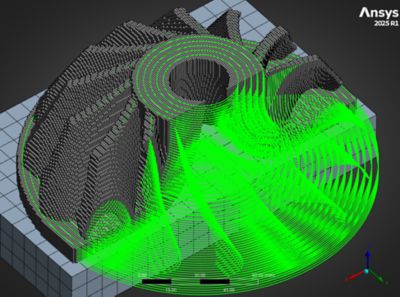
Additive
Wir freuen uns, Ihnen die Integration der fortschrittlichen Simulationstechnologie von Ansys in Materialise Magics ankündigen zu können, einer strategischen Partnerschaft, die auf dem Weg zur Transformation der additiven Fertigung in Metall steht. Diese Zusammenarbeit verbessert die Produktqualität, senkt Kosten und fördert Innovationen, indem Risiken minimiert und Deformation von Teilen sowie thermische Spannung frühzeitig vorhergesagt und behoben werden.

Simulation Autonomer Fahrzeuge
Die Ansys AV-Simulation für 2025 R1 verbessert die Sicherheit, Effizienz und Benutzerfreundlichkeit autonomer Systeme. Zu den wichtigsten Funktionen gehören eine genaue 3D-Sensorpositionierung, IP-Schutz für Kamera-Imager und standardisierte Verbindungen für die Radarsensor-Schnittstelle. Die verbesserte Interoperabilität und Konnektivität mit AVxcelerate Autonomy gewährleistet eine nahtlose Integration und verbesserte Anpassungsfähigkeit und treibt die autonome Branche mit robusten, sicheren Lösungen voran, die hohe Sicherheitsstandards erfüllen und die Leistung sowie die Benutzererfahrung verbessern.

Connect
Diese Version erweitert die Möglichkeiten beim Digital Engineering durch Werkstoffe (Granta) und Simulationsdaten (Minerva), die jetzt leichter in CAD, CAE und PLM integriert werden können, und bietet eine verbesserte UX, um die Suche und den Export zu verbessern. Ermöglichen Sie MBSE der nächsten Generation mit der erweiterten SysML v2-Unterstützung und dem Modellmanagement im Ansys System Architecture Modeler mit einer tieferen Integration in Ansys ModelCenter. Ansys optiSLang™ erweitert seine Möglichkeiten um neue verteilte Computing-Optionen und fortschrittliche Algorithmen, die den technischen Workflow des Kunden flexibler und leistungsfähiger machen.
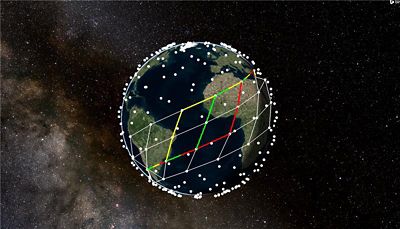
Digital Missions Engineering
Ansys Digital Mission Engineering führt mehrere wichtige Aktualisierungen und Verbesserungen für 2025 R1 ein, die es Benutzer*innen ermöglichen, verschiedene Herausforderungen beim Mission Design zu bewältigen. Diese wichtigen Aktualisierungen verbessern die Funktionen für Mission Design und Analyse, HF-Modellierung und Integration von Systems Engineering, um die wachsende Komplexität und den Umfang moderner Systeme in der Luft- und Raumfahrt sowie der Verteidigung besser zu unterstützen.

Digitale Zwillinge
Ansys 2025 R1 erweitert seine Funktionen für digitale Zwillinge um Hybridanalysen, skalierte Bereitstellung und neue Funktionen für mehr Flexibilität und Benutzerfreundlichkeit. Zu den wichtigsten Aktualisierungen gehören der Ansys Unified Installer, eine skriptfähige Python-Schnittstelle für Reduced-Order-Modelle (ROMs) und Verbesserungen bei der Nachverarbeitung von Hybridanalysen. Ansys TwinAI™ unterstützt jetzt den SysML v2-Snippet-Export, menübasierte Hilfe, erweiterte Dateiexportoptionen und neue Beispiele für PyAEDT und PyTwin, um die Entwicklung zu optimieren.
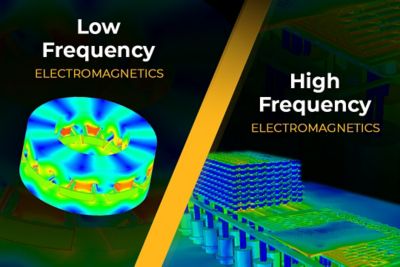
Elektronik
Beschleunigen Sie Ihre Markteinführungszeit und fördern Sie Innovationen mit neuen Funktionen, die die Simulationsgeschwindigkeit und -genauigkeit erhöhen und gleichzeitig die Benutzererfahrung verbessern. Die Vorlage für Axialflussmaschinen verbessert die Vernetzungsgenauigkeit und -geschwindigkeit für elektrische Geräte. Verbesserte TZR-Importgeschwindigkeit und Workflows vereinfachen die 3D-IC-Modellierung. Erleben Sie einen schnelleren A-Phi-Wirbelstrom-Solver für die Frequenzbereichsanalyse mit DC-Vorspannung, der speziell für Leistungselektronik entwickelt wurde. Profitieren Sie von flexibleren und präziseren Simulationen auf Systemebene, schnelleren Auswertungen des IC-Designs, optimierten PI-Analyse-Workflows und KI/ML-gesteuerten Zeit- und Speichervoraussagen, die die Leistung optimieren.
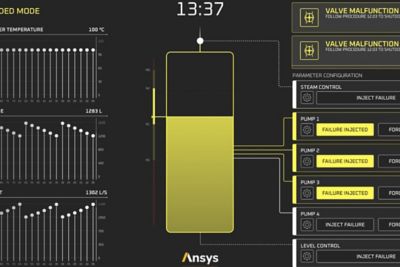
Embedded Software
Die Neuerungen der Ansys Embedded Software 2025 R1 setzen die Dynamik unserer letzten Version fort. Auch die zertifizierte Softwaresicherheit für Kunden steht weiterhin im Mittelpunkt. Die neue Version von Ansys SCADE enthält deutliche Verbesserungen bei der zertifizierten/qualifizierten Codegenerierung für die Sicherheitsstandards DO178C und ISO 26262 und ist weiterhin führend in der Zertifizierung/Qualifizierung für die Automobil- sowie die Luft- und Raumfahrtindustrie. Scade One bietet in der neuesten Version einen vollständigen Workflow für Tests und stellt PyScadeOne vor.
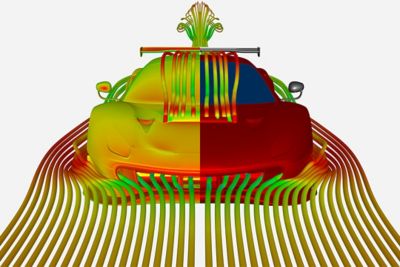
Fluids
Ansys Fluids 2025 R1 bietet weiterhin wichtige Verbesserungen, um die Leistungs- und Produktivitätsanforderungen unserer Kunden zu erfüllen. Der Fluent-GPU-Solver unterstützt jetzt zusätzliche Physik, darunter das Verbrennungsmodell von FGM, Partikel- und Tröpfchenmodellierung mit dem diskreten Phasenmodell (DPM), Strahlung von Oberfläche zu Oberfläche und vieles mehr. Zu den Fortschritten in den Bereichen Thermal Desktop, Rocky und CFX gehören dramatische Leistungsverbesserungen, neue Integrationen für Multiphysik-Systeme und zusätzliche Optimierungsoptionen.
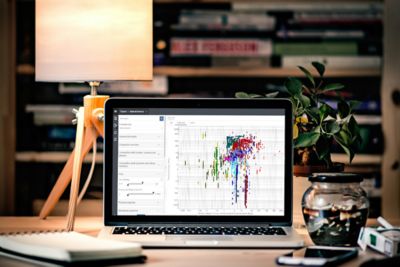
Materials
Ansys Granta 2025 R1 bietet zahlreiche neue Funktionen und Verbesserungen, die Ansys Granta MI-Anwender*innen eine einheitliche Benutzererfahrung auf CAD-, CAE- und PLM-Plattformen bieten. Darüber hinaus umfasst es erhebliche Verbesserungen bei der Suche und führt neue Materialdaten in den Bereichen Polymere, Elektromagnetik und Nachhaltigkeit in die Materialbibliotheken ein. Dadurch können Techniker*innen und Designer*innen produktiver arbeiten, ohne ihre bevorzugten Engineering-Tools aufgeben zu müssen.
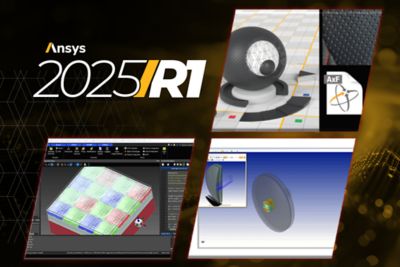
Optik
Ansys Optics ist jetzt in der Version 2025 R1 erhältlich, die sich auf einheitliche Multiphysik-Analysen, optimierte Workflows und verbesserte Benutzererfahrungen konzentriert. Zu den wichtigsten Aktualisierungen gehören die Doppelbrechung von Spannungen in STAR, Design für die Fertigung – Mechanical Pivot Points (MPVT), Pervasive Insights – dunkles Design, X-Rite AxF-Unterstützung, Python-basierte API, fortschrittliches Design optischer Linsen für Scheinwerfer, Verbesserungen der Leistung von Multi-GPU und Vernetzung sowie eine moderne Benutzeroberfläche für Lumerical FDTD. Diese Aktualisierungen zielen darauf ab, Simulationen, Genauigkeit und Zusammenarbeit zu verbessern und Ansys Optics als führende Suite bei Simulation und Design für die Optik zu festigen. Die aktualisierte Software ist auf GitHub verfügbar und ermöglicht eine einfache Einführung in Simulations-Pipelines und die Entwicklung maßgeschneiderter GUI.

Sicherheitsanalyse
Mit 2025 R1 werden neue UX- und UI-Funktionen über die gesamte Produktreihe der Ansys Sicherheitsanalyse hinweg eingeführt, um eine verbesserte Arbeitsweise und ein neues Maß an Effizienz zu bieten. Da Sicherheitsprojekte immer komplexer werden, zielen unsere Lösungen darauf ab, sich an die Bedürfnisse der Kunden anzupassen. Unsere modellbasierte Sicherheitslösung ermöglicht es Benutzer*innen, FMEAs schneller und effektiver durchzuführen, indem das Tool intelligenter navigiert wird. Dies ermöglicht eine schnelle Aktualisierung der Analyse, selbst wenn sich die Hardware weiterentwickelt.
Die Digital Safety Manager-Plattform (DSM) bietet jetzt kundendefinierte Sicherheits-KPIs, die durch Live-Berichte von Ansys medini-Daten gespeist werden, um die Lücke zwischen Sicherheitstechniker und -manager zu schließen. Machen Sie Ihre Sicherheitsanalyse zu einem sichtbaren Teil des Produktentwicklungsprozesses.
Halbleiter
Die Version 2025 R1 beschleunigt nahezu jedes Halbleiterprodukt erheblich, während PowerArtist™ eine leistungsstarke neue Methode zur Analyse und Behebung von durch Glitches hervorgehobener Verlustleistung einführt. PowerX™ ist ein neues Softwareprodukt für das Debugging parasitärer Verluste in Halbleiterbauelementen. RedHawk-SC Security™ hat sich mit eShard™ zusammengetan, um die Side-Channel-Sicherheitsanalyse zu erweitern. RedHawk-SC Electrothermal™ hat mit TSMC™ zusammengearbeitet, um einen Workflow zur Bewertung thermischer Fertigungsspannungen in 3D-ICs zu entwickeln.
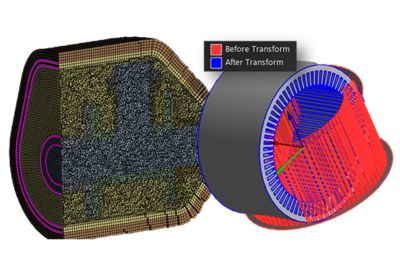
Strukturmechanik
Die Version 2025 R1 von Ansys Structures bietet eine Reihe neuer Funktionen, die unseren Kunden ganzheitliche, nach Produkten kategorisierte Vorteile bieten sollen. Ansys Mechanical umfasst leistungsstarke Verbesserungen bei den Solver-Funktionen, eine umfassende Integration für NVH-Anwendungen (Rauschen, Vibrationen und Rauheit) sowie fortschrittliche Tools für die Analyse des Material- und Risswachstums. Diese Upgrades ermöglichen es Techniker*innen, große, anspruchsvolle Modelle mit verbesserter Genauigkeit, Effizienz und Zuverlässigkeit in verschiedenen Branchen zu handhaben. Ansys LS-DYNA bietet neue Solver und Methoden, die praxisnahe Anwendungen genau beschreiben, von Gasströmen bis hin zu Klebstoffen und Batterien. Ansys Sherlock beinhaltet neue Funktionen, die sich auf die Voraussage der Lebensdauer von BGA-Paketen konzentrieren, sowie PySherlock-Updates mit neuen APIs und die Automatisierung bestimmter Workflows.






